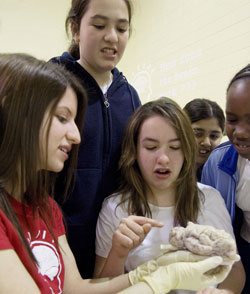Using gray matter: Kids get past 'Ew'

Psychology student Sarah Vannier allows Mariya Turchin, Alexandra Monette (seated), Zubda Mir and Nicole Pindling the opportunity to get up close and personal with a cow brain.
Photo by andrew dobrowolskyj
“If you’re good, and listen well, we happen to have a real cow’s brain that we just might let you touch later.”
This proposition, made by master’s student Jonathan Santo, may not appeal to you. But it was more than ample for 60 boisterous sixth graders at LaSalle Elementary Senior School.
“Ewww!” they roared, in a burst of excited chatter. “Gross!”
Concordia Psychology students Santo and Sarah Vannier were among a fleet of students from Montreal universities who made classroom visits in local schools to give students the goods on gray matter, as part of Brain Awareness Week (BAW).
“Honestly, I love doing these presentations,” said Santo, a five-year veteran of the program. “The kids love everything: They’re so open to the experience of learning. And who knows? They could grow up to be brain researchers.”
Among other things, the LaSalle students learned how messages from the brain travel throughout the body, about the five senses, and the difference between the occipital lobe (which controls vision) and the hippocampus (where memories are stored).
They discovered that if all 100 billion of the brain’s cells – called neurons – were unravelled and placed end to end, they would form a line 100 kilometres long.
When the pičce de resistance – the preserved bovine brain – came out, so did the rubber gloves for a truly hands-on experience.
Nicole Pindling shied away in mock horror before reluctantly prodding it with her gloved finger. “I thought it would feel like spaghetti,” she confessed, and said she was surprised that it didn’t.
“It looks like it’s going to be hard, but it’s just slimy,” observed Chanprit Jawanda. “But I wonder how they get it out of the cow’s head?”
Alexandra Monette cut straight to the chase. “It’s just nasty! Some parts of it were still warm.”
Vannier said the brain is a poignant learning tool for these children, “because at this stage, their brains are still growing. Right now, their brains are about the same size as the cow’s.”
During the presentation, she enlisted the assistance of volunteers to help her perform a series of experiments. Students learned how the sense of smell affects that of taste by noting how Skittles candy becomes virtually tasteless when they hold their noses.
When one brave subject was gently pricked with two toothpicks spaced about one centimetre apart on the upper arm, lower arm and fingertips, Vannier explained why he was able to discern that there were two separate toothpicks only on his fingers.
“On the upper arm you feel only one toothpick, but you felt both in your fingertips because there are more touch receptors there.”
The elementary school visits were only a part of the BAW activities that took place from March 13 to 19. Visits were also made to high schools, where students learned how drugs affect the brain.
Concordia students also helped organize the speaker series, which addressed topics such as depression and hyperactivity.
